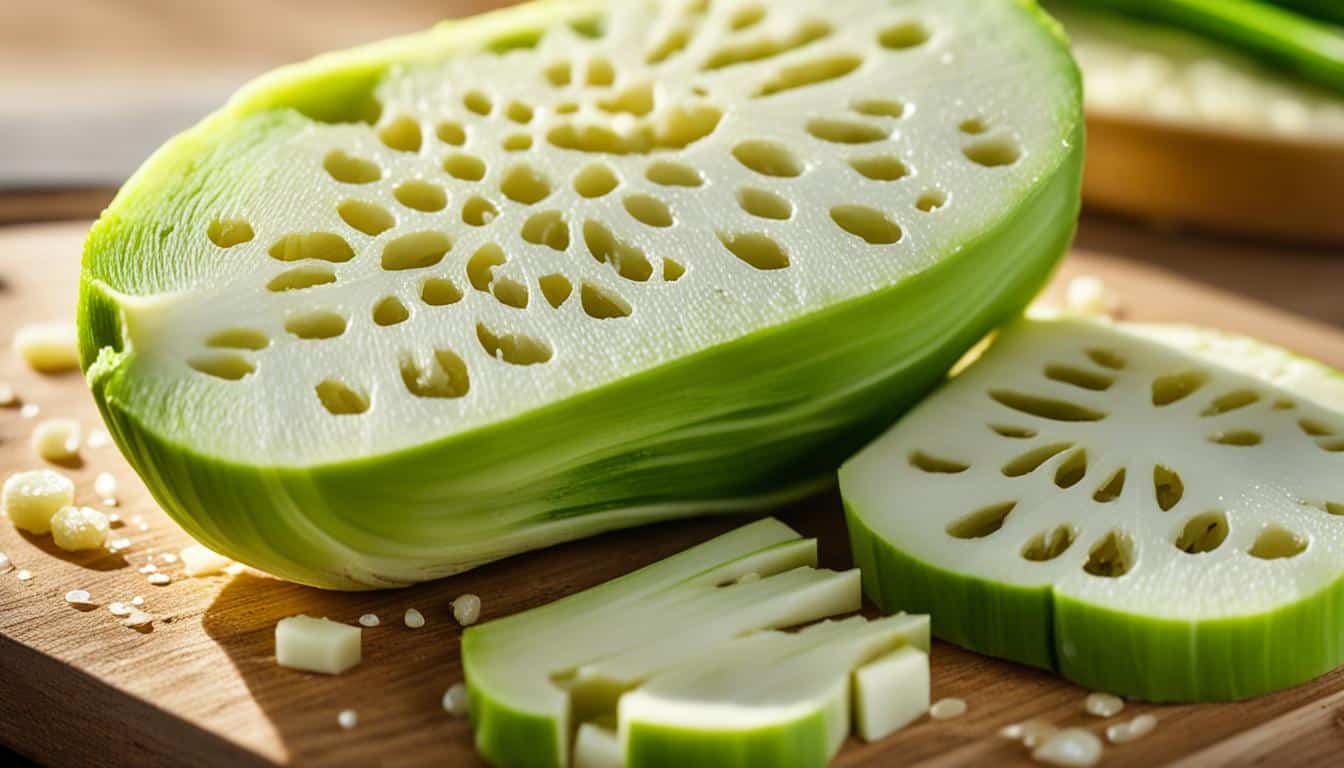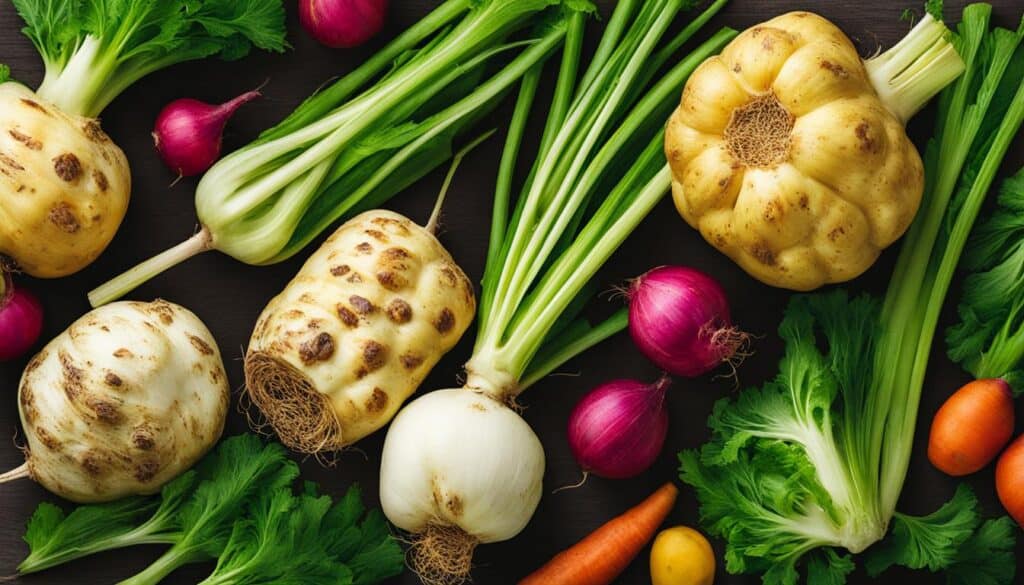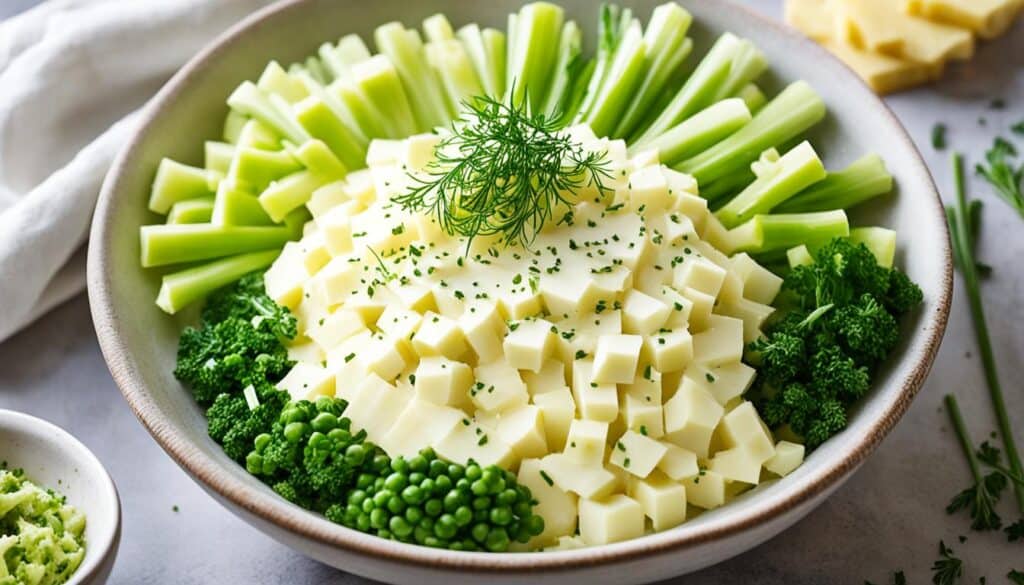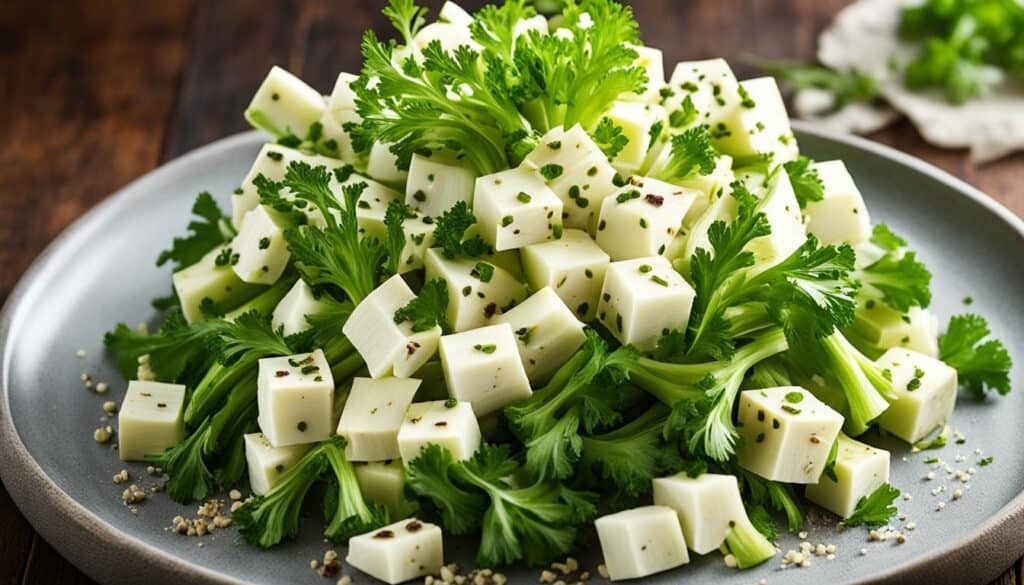Did you know that celery root, also known as celeriac, is a root vegetable that offers a plethora of health benefits? This humble vegetable may not be the most glamorous at first glance, but its nutritional value and versatility in cooking make it a standout addition to your diet.
Rich in vitamins K, C, and B6, as well as phosphorus, potassium, and fiber, celery root provides a low-calorie, high-fiber option that can support your overall well-being. From reducing the risk of bone fractures to helping lower blood pressure and manage type 2 diabetes, the benefits of celery root are truly impressive.
In this article, I will uncover the intriguing folklore surrounding celery root, delve into its surprising nutritional profile, explore the latest research on its health benefits, provide tips on selecting and storing this unique vegetable, and even share a delicious recipe to help you incorporate celery root into your meals. Get ready to unlock the diverse wonders of celery root!
Key Takeaways:
- Celery root, also known as celeriac, is a versatile and nutritious root vegetable.
- It is rich in vitamins K, C, and B6, as well as phosphorus, potassium, and fiber.
- Research suggests that celery root may help reduce the risk of bone fractures, high blood pressure, and type 2 diabetes.
- Celery root can be enjoyed raw in salads, cooked in soups and gratins, or even baked into chips.
- Try the Celery Root and Cauliflower Puree recipe for a delicious and healthy dish.
The Folklore of Celery Root
Celery root, also known as celeriac, possesses a fascinating folklore that has been passed down through generations. This unassuming vegetable, often referred to as knob celery or turnip-rooted celery, is considered the “ugly duckling” of the produce world due to its peculiar appearance characterized by a bulbous, hairy root. Despite its unconventional looks, celery root has captured the attention and imagination of many cultures throughout history.
“Celery root, the ugly duckling of the vegetable kingdom, has a distinct charm and flavor all its own.”
The roots of celery root’s folklore can be traced back to ancient times and even find mention in Homer’s epic poem, “Odyssey,” which dates back to 800 B.C. Here, the Greeks revered celery root for its nutritional and medicinal properties. It was believed to have aphrodisiac qualities and became associated with fertility and love.
The Romans also recognized the value of celery root. They incorporated it into their medicinal practices and considered it a valuable herbal remedy. Celery root was used to treat various ailments, including digestive issues and respiratory conditions.
Celery root’s charm and versatility continue to capture the imagination of cooks and food enthusiasts around the world. Its ancient folklore and rich history add a touch of mystique to this humble vegetable, making it a fascinating ingredient to explore.
| Folklore | Historical Significance |
|---|---|
| Aphrodisiac properties | Greeks and Romans believed that it had the power to enhance desire and promote love. |
| Medicinal purposes | Ancient Greeks and Romans used celery root as a remedy for various ailments due to its perceived healing properties. |
| Association with fertility | The shape of celery root was thought to symbolize fertility, making it a popular choice for certain rituals and celebrations. |
The Facts About Celery Root
Celery root, a member of the parsley family, is a unique and nutritious vegetable closely related to celery, carrots, and parsnips. Unlike its green celery stalks, celery root is grown for its underground tuber, which is harvested when it reaches a size of three to five inches in diameter.
With its rough and gnarled skin, celery root may not win any beauty contests, but don’t let its appearance fool you. Beneath the rough exterior lies a crisp white flesh that offers a subtle flavor reminiscent of both celery and parsley.
One of the standout features of celery root is its impressive nutritional profile. A one-cup serving of this vegetable provides a significant amount of essential nutrients, including:
| Nutrient | Amount per Serving |
|---|---|
| Vitamin K | 24% of the Daily Value (DV) |
| Phosphorus | 13% of the DV |
| Potassium | 10% of the DV |
These nutrients are crucial for maintaining bone health and supporting proper cardiovascular function.
The Findings on Celery Root’s Health Benefits
Research has shown that consuming foods rich in vitamin K, such as celery root, may help reduce the risk of bone fractures. Celery root is also a good source of vitamin C, which has been linked to a reduced risk of high blood pressure. A study on the role of fruits and vegetables in reducing the risk of type 2 diabetes found that root vegetables, including celery root, are particularly effective. These findings highlight the potential health benefits of incorporating celery root into a balanced diet.
| Health Benefit | Related Nutrient |
|---|---|
| Reduced risk of bone fractures | Vitamin K |
| Reduced risk of high blood pressure | Vitamin C |
| Reduced risk of type 2 diabetes | Root vegetables |
“Research has shown that consuming foods rich in vitamin K, such as celery root, may help reduce the risk of bone fractures.” – Dr. Jane Anderson, Medical Researcher
The Benefits of Vitamin K
Vitamin K is an essential nutrient that plays a crucial role in blood clotting and bone metabolism. It helps activate proteins involved in these processes, promoting proper blood clot formation and maintaining bone density and strength. Including vitamin K-rich foods like celery root in your diet can contribute to overall bone health and reduce the risk of fractures.
The Role of Vitamin C in Heart Health
Vitamin C is a powerful antioxidant that helps protect cells from damage caused by free radicals. Research has shown that a higher intake of vitamin C is associated with a reduced risk of high blood pressure, a major risk factor for cardiovascular disease. Adding celery root, which is a good source of vitamin C, to your meals can contribute to a heart-healthy diet.
Root Vegetables and Type 2 Diabetes
Type 2 diabetes is a chronic condition characterized by impaired insulin function and high blood sugar levels. Studies have shown that a diet rich in fruits and vegetables, including root vegetables like celery root, can help reduce the risk of developing type 2 diabetes. This may be due to their high fiber content, which can help regulate blood sugar levels and improve insulin sensitivity.
How to Select and Store Celery Root
Celery root, also known as celeriac, is a versatile and nutritious vegetable that can be enjoyed in various recipes. To ensure you choose the best celery root and keep it fresh for longer, follow these tips:
Selecting Celery Root
- Choose celery root that is in season for the best flavor and availability. It is usually best in fall through early spring, but you can find it year-round.
- Look for celery roots that feel firm and heavy for their size. This indicates their freshness and crispness.
- If the stalks are still attached to the celery root, make sure they appear fresh and green. Avoid celery roots with wilted or yellowing stalks.
Storing Celery Root
To keep your celery root fresh and flavorful for an extended period, consider the following storage options:
- If you have a root cellar, this can be an ideal storage location for celery root. The cool and dark conditions in a root cellar mimic the vegetable’s natural environment and help maintain its freshness. Make sure to remove any soil from the root before storing.
- If a root cellar is not available, the refrigerator is the next best option for storing celery root. Wrap the root in a plastic bag to preserve its moisture and prevent it from drying out. Place it in the vegetable crisper drawer, which maintains a cool and slightly humid environment.
By properly storing celery root, it can last for several months, ensuring a steady supply of this versatile vegetable throughout the year.
Now that you know how to select and store celery root, you can enjoy its crisp texture and unique flavor in various culinary creations.
Notable Nutrients of Celery Root
Celery root, also known as celeriac, is not only delicious but also packed with nutrients that support overall health. Let’s explore the notable nutrients that make celery root an excellent addition to your diet.
Nutritional Profile of Celery Root
Celery root offers a range of essential vitamins and minerals that contribute to its impressive nutritional value. Here is a breakdown of the key nutrients found in celery root:
| Nutrient | Amount per Serving |
|---|---|
| Calories | 66 |
| Dietary Fiber | 3 grams |
| Vitamin C | 20% of the Daily Value (DV) |
| Vitamin K | 23% DV |
| Vitamin B6 | 8% DV |
| Phosphorus | 7% DV |
| Potassium | 9% DV |
| Manganese | 8% DV |
As shown in the table, celery root is a low-calorie vegetable, with just 66 calories per one-cup serving. It is also a great source of dietary fiber, providing 3 grams per serving. This fiber content promotes healthy digestion and helps keep you feeling full and satisfied.
Vitamin C plays a crucial role in supporting a healthy immune system and acts as an antioxidant that protects your cells from damage. Meanwhile, vitamin K is essential for bone health and blood clotting.
Celery root also contains vitamin B6, which contributes to brain development and function, phosphorus for strong bones and teeth, potassium for proper muscle function and nerve signaling, and manganese, an antioxidant that supports brain health and metabolism.
With its impressive nutrient profile, including its low-calorie count, celery root is a fantastic choice for those looking to maintain a healthy diet. Incorporating celery root into your meals allows you to enjoy its delicious flavor while reaping the numerous health benefits it offers.
Recipe: Celery Root and Cauliflower Puree
Looking for a healthy and delicious side dish or main course? Try this simple recipe for Celery Root and Cauliflower Puree. It’s not only low in calories, but also packed with nutritious ingredients that will leave you feeling satisfied and nourished.
Ingredients:
- 1 celery root, peeled and chopped
- 1 small head of cauliflower, chopped
- 2 tablespoons olive oil
- Salt and pepper to taste
Directions:
- Steam the celery root and cauliflower until tender.
- Transfer the steamed vegetables to a food processor and add olive oil, salt, and pepper.
- Puree until smooth and creamy.
- Season to taste with additional salt and pepper, if desired.
- Serve hot and enjoy!
This tasty puree is a perfect accompaniment to grilled chicken or fish. It’s also great as a standalone dish for those following a vegetarian or vegan diet. Each serving of Celery Root and Cauliflower Puree contains only 88 calories, making it a guilt-free option for those watching their calorie intake. In addition, this dish is high in fiber, vitamins, and minerals, adding a nutritious boost to your meal.
Celeriac: A Versatile and Nutritious Vegetable
Celeriac, also known as celeriac, knob celery, or turnip-rooted celery, is a root vegetable that offers both versatility and nutrition. Packed with vitamins, minerals, and antioxidants, celeriac is a beneficial addition to any diet. With its mild flavor and unique texture, it adds depth and variety to a range of dishes.
One of the key advantages of celeriac is its low-fat and low-calorie content, making it an ideal choice for those aiming to maintain a healthy weight. Let’s explore the nutritional benefits it offers:
| Nutrient | Amount per Serving |
|---|---|
| Vitamins (K, C, B6) | Provides essential vitamins for various bodily functions |
| Minerals (Phosphorus, Potassium) | Contributes to bone health and cardiovascular function |
| Antioxidants | Helps protect the body from oxidative stress and free radicals |
| Dietary Fiber | Promotes a healthy digestive system and aids in weight management |
I’ve always loved the versatility of celeriac. From roasted celeriac fries to creamy celeriac mash, this humble root vegetable never disappoints in delivering both flavor and nutrition.
Celeriac’s unique taste and texture make it a great addition to soups, stews, salads, and even as a side dish. Whether it’s mashed, roasted, boiled, or incorporated into a hearty gratin, celeriac adds a delightful earthy note to every preparation.
If you’re looking for a delicious and nutritious way to incorporate celeriac into your meals, try this savory Roasted Celeriac Salad:
- Preheat the oven to 400°F.
- Peel and cut celeriac into bite-sized pieces.
- Toss the celeriac with olive oil, salt, and pepper.
- Spread the celeriac evenly on a baking sheet.
- Roast in the oven for 25-30 minutes, or until golden and tender.
- In a separate bowl, combine mixed greens, cherry tomatoes, and crumbled feta cheese.
- Add the roasted celeriac on top.
- Drizzle with balsamic glaze and serve.
Enjoy the unique flavors and health benefits that celeriac brings to your table. Experiment with different cooking methods and recipes to discover your favorite way of incorporating this underrated root vegetable into your meals.
How to Incorporate Celery Root Into Your Diet
When it comes to adding celery root to your meals, the options are limitless. This versatile vegetable can be enjoyed in both raw and cooked forms, elevating the flavors and nutritional value of your dishes. Here are some creative ways to incorporate celery root into your diet:
Raw:
- Grate celery root and add it to salads for a refreshing crunch.
- Use finely sliced celery root as a key ingredient in coleslaws for added texture.
Cooked:
- Puree celery root into soups for a velvety texture and delicate flavor.
- Slice celery root and roast it with your favorite seasonings for a hearty side dish.
- Add slices of celery root to gratins for a unique twist on traditional recipes.
Snacks:
Celery root can even be transformed into tasty and healthy snacks:
Slice celery root into thin chips, toss them with a drizzle of olive oil and a sprinkle of sea salt, then bake until crispy. These homemade celery root chips make a delicious alternative to traditional potato chips.
With its mild and slightly nutty flavor, celery root pairs well with various seasonings and ingredients, making it a versatile addition to a wide range of recipes.
Celery Root Chips Recipe
| Ingredients | Instructions |
|---|---|
|
|
This simple recipe is a great way to enjoy the natural flavor and crunch of celery root. Savor these homemade chips as a healthy snack or serve them as a unique appetizer at your next gathering.
Conclusion
Celery root, also known as celeriac, is a highly nutritious and versatile vegetable that offers numerous benefits for your health and well-being. With its rich blend of vitamins, minerals, fiber, and antioxidants, celery root is a powerhouse of nutrition that can support your overall health.
One of the key benefits of celery root is its ability to promote bone health. Packed with vitamin K, celery root can help strengthen your bones and reduce the risk of fractures. Additionally, its high content of vitamin C contributes to a healthy immune system and may lower the risk of high blood pressure, leading to a healthier heart.
Not only is celery root highly nutritious, but it is also low in calories and fat, making it an excellent choice for those striving to maintain a healthy weight. Its versatility in the kitchen is another advantage, as it can be incorporated into a myriad of recipes. Whether enjoyed raw in salads, cooked in soups and gratins, or baked into crispy chips, celery root adds a unique flavor and texture to your dishes.
By exploring the culinary wonders of celery root, you can unlock its surprising benefits and enhance the nutritional value of your meals. So, next time you visit the grocery store, be sure to grab a celery root and explore the endless possibilities to create delicious and nutritious dishes.










Leave a Reply